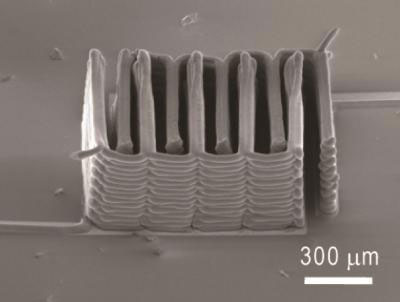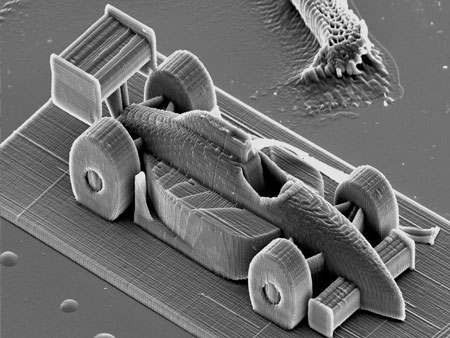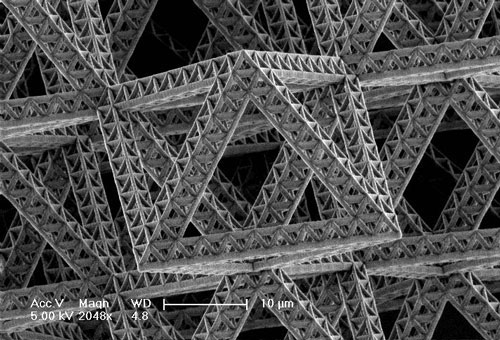| Posted: Sep 26, 2014 | |
Nanotechnology and 3D-printing |
|
| (Nanowerk Spotlight) Additive manufacturing is a way of making 3-D objects by building up material, layer upon layer, with the guidance of a digital design. The processes are engineered to use material more efficiently, give designs more flexibility and produce objects more precisely. Above all, they make things quickly (read more: "The engineering behind additive manufacturing and the 3-D printing revolution"). | |
| 3-D printing was developed by a Massachusetts Institute of Technology team led by Emanuel Sachs in the late 1980s (patent 5204055). Also known as binder jetting, the technique involves laying down a layer of a powder and then squirting a liquid binder on the areas to be solidified. While similar to conventional ink jet printers, 3-D printers are able to build additional layers on top of previous ones to construct 3-D objects, even sophisticated objects that serve as medical implants (if you want to read up on 3D printing in general, check out our guides on the best 3D printers for beginners and professionals as well as the best repositories of free 3D printing models and design files). | |
| These 3D printing techniques are reaching a stage where desired products and structures can be made independent of the complexity of their shapes – even bioprinting tissue is now in the realm of the possible. | |
| Already, 3D printing can now be used to print lithium-ion microbatteries the size of a grain of sand. To make the microbatteries, a team based at Harvard University and the University of Illinois at Urbana-Champaign printed precisely interlaced stacks of tiny battery electrodes, each less than the width of a human hair. | |
 |
|
| This image shows the interlaced stack of electrodes that were printed layer by layer to create the working anode and cathode of a microbattery. (Image: Wyss Institute for Biologically Inspired Engineering at Harvard) | |
| Applying 3D printing concepts to nanotechnology could bring similar advantages to nanofabrication – speed, less waste, economic viability – than it is expected to bring to manufacturing technologies. | |
| For instance, printing three-dimensional objects with incredibly fine details is already possible using a direct laser writing method called two-photon lithography (read more: "3D-printer with nanoscale precision"). With this technology, tiny structures on a nanometer scale can be fabricated such as the example of the race car – which measures only 285 µm in length. | |
 |
|
| A 285 µm long race car, 3D-printed at the Vienna University of Technology. (Image: Vienna University of Technology) | |
| The entire process can be seen here in this video: A race car with dimensions of 330x130x100 µm3 is fabricated. The structure consists of 100 layers, each made of an average of 200 polymer lines. It is finished in 4 minutes and resembles the CAD file at a precision of ±1 µm: | |
| Another example of two-photon lithography is the fabrication of elaborate fractal truss micro- and nanostructures such as the one below. Here, a pattern in a polymer, allowing a laser beam to crosslink and harden the polymer wherever it is focused. In contrast to a 3D-printing-only process, though, this technique requires additional steps such as coating the scaffold and etching out unused polymer. | |
 |
|
| Fractal nanotruss. Individual components are as small as 5 nanometers. (Image: L. Meza, L. Montemayor, N. Clarke, J. Greer/Caltech) | |
| Previously, 3D-printing has primarily been used to generate replicas of natural and man-made structures, such as bioimplants (see for instance: "3D-printed living human cartilage, made to order"), toys, art statues, structural metallic components, etc. But this is where it gets interesting: With advanced 3D printing techniques, it is possible to manufacture micro- and even nanoscale complex structures that are not feasible by other manufacturing techniques. | |
| For instance, It is nearly impossible with current cutting techniques to shape brittle ceramics into higher order 3D structures, which could have a huge impact on compact sensor designs, tunable acoustic arrays, efficient energy scavengers, and diagnostic devices. | |
| To address this issue, researchers at UC San Diego recently have demonstrated a novel tool for fabricating 3D piezoelectric materials that relies on piezoelectric nanoparticles embedded in a photoliable polymer solution ("3D Optical Printing of Piezoelectric Nanoparticle?Polymer Composite Materials"). | |
| As Gary J. Cheng and co-authors write in their recent Perspective article in ACS Nano ("Three-Dimensional Printing of Complex Structures: Man Made or toward Nature?"), by applying 3D printing techniques, it is possible to fabricate evolved structures, such as shark skin, lotus effect, bio-inspired sensors, and so on. | |
| These advanced structures can also be used for piezoelectric applications. As shown in the figure below, 3D printing enables the feasibility of claw structures for electro-mechanical transfer. | |
 |
|
| Schematic of a bio-inspired claw design of 3D piezoelectric structures. The snapshot of the structure at different positions: (a) open the claw, (b) close the claw, and (c) grab the ball. (Reprinted with permission by American Chemical Society) | |
| "In this complex structure, many functional structures could be printed to make the structure as smart as a crab claw," write Cheng et al. "For example, a position sensor could locate the ball and help the claw move to the target. A piezoelectric material could be used in the bones to apply the force to grab the ball. A controller could be embedded to decide how much force to use to grab the ball and how the claw will open and close. Additionally, the end of the claw could be made from a different material and with a curved/sharp shape to easily grab the ball." | |
| In another example, earlier this year, a group of researchers in Korea has shown that nanoscale 3D objects such as free-standing nanowalls can by constructed by an additive manufacturing scheme. Even without the motion of the substrate, nanojets are spontaneously laid down and piled to yield nanowalls. | |
| Taking this work further, full 3D control of an electrospun nanojet could possibly revolutionize current nanofabrication technologies. However, to realize full 3D nanofabrication, the precise control of the nanojet needs to be considerably improved. | |
| These future sophisticated methods to control the nanojets have the potential to realize rapid 3D printing of complicated shapes, which can be used for bioscaffolds, nanofilters and even nanorobots. This is an example of just one area where nanotechnology can be used in the future | |
 By
Michael
Berger
– Michael is author of three books by the Royal Society of Chemistry:
Nano-Society: Pushing the Boundaries of Technology,
Nanotechnology: The Future is Tiny, and
Nanoengineering: The Skills and Tools Making Technology Invisible
Copyright ©
Nanowerk LLC
By
Michael
Berger
– Michael is author of three books by the Royal Society of Chemistry:
Nano-Society: Pushing the Boundaries of Technology,
Nanotechnology: The Future is Tiny, and
Nanoengineering: The Skills and Tools Making Technology Invisible
Copyright ©
Nanowerk LLC
|
|
|
Become a Spotlight guest author! Join our large and growing group of guest contributors. Have you just published a scientific paper or have other exciting developments to share with the nanotechnology community? Here is how to publish on nanowerk.com. |
|
